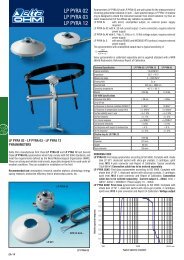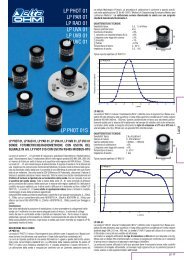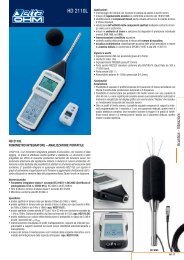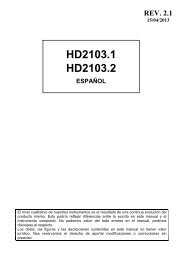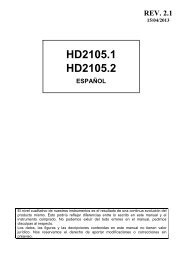HP480 T480.1 S.TC2.480.2 - Delta Ohm S.r.l.
HP480 T480.1 S.TC2.480.2 - Delta Ohm S.r.l.
HP480 T480.1 S.TC2.480.2 - Delta Ohm S.r.l.
You also want an ePaper? Increase the reach of your titles
YUMPU automatically turns print PDFs into web optimized ePapers that Google loves.
FORMATION MÉDICALE CONTINUEDISCUSSIONColon hemangiomas are rare, benign vascular lesions, withpatients usually presenting with repetitive painless bleedingfrom the rectum, but there is the potential for massive hemorrhage.Cavernous hemangiomatosis of the colon and liver,though rare, have been previously reported. 2 About 80% ofcolonic hemangiomas are found on histology to be of thecavernous subtype, with 70% occurring in the rectum. 1 NotABsurprisingly 60%–90% of patients present with bleedingfrom the rectum, but 17% will present with obstructivesymptoms, as was the case with our patient. Cavernoushemangiomas have a tendency to run in families, and a highdegree of clinical suspicion is needed to avoid unnecessarysurgical procedures, which have been reported in up to 80%of patients, and delays in diagnosis of up to 19 years. 1 Variouscongenital abnormalities such as vertebral defects,imperforate anus, tracheoesophageal fistula, radial and renaldysplasia (VATER complex) and skin lesions have beenreported. An established association with ovarian dermoidcysts has not been previously described and, to our know -ledge, ours it the first report to raise the possibility of anassociation. Additional case reports are warranted, however,to establish such an association. Skin involvement in additionto multiple gastro intestinal organ involvement shouldraise suspicion of blue rubber bleb nevus syndrome. 3Investigations of the affected patients will be dictated bypresenting symptoms. Obstructive large bowel symptomswarrant the use of barium enema or colonoscopy. Al -though angiography and scintigraphy may be useful,colonoscopy, CT colonography and magnetic resonanceimaging are all more accurate methods for establishing thediagnosis, with colonoscopy considered to be the methodof choice. 4 Compared with optical colonoscopy, CTcolonography has the advantage of greater accuracy indetermining wall thickening and extramural extension. 1Complete resection is the definitive therapy for symp tom -atic colonic hemangiomas. This usually means a segmentalbowel resection at open or laparoscopic surgery, as mostpatients have diffuse infiltrative lesions. The presence of apolypoid mass of appropriate size may lend itself successfullyto endoscopic polypectomy or endoscopic mucosal resection.5 Localized flat lesions can be treated with endoscopiclaser therapy or sclerotherapy with systemic steroid or interferontherapy with variable results. 6 Complete surgical resectionresults in a good prognosis for these benign lesions.Competing interests: None declared.ReferencesCFig. 2. (A) Resected segment of colon opened to reveal the polypoidmulticystic mass protruding into the lumen. Altered blood isfocally evident in the lumen and the lesion extends through thewall to involve the pericolic tissues. Histologic sections of thetumour from the (B) colon showing large dilated blood-filled vascularspaces with fibrous wall within the submucosa and ectaticcapillaries in the overlying lamina propria and (C) the liver biopsyshowing unremarkable liver parenchyma within the fibrous wallof the large dilated vascular spaces (hematoxylin and eosin stain,original magnification ×560).1. Hsu RM, Horton KM, Fishman EK. Diffuse cavernous haemangiomatosisof the colon: findings on three-dimensional CT colonography.AJR Am J Roentgenol 2002;179:1042-4.2. Marinis A, Kairi E, Theodosopoulos T, et al. Right colon and liverhemangiomatosis: a case report and a review of the literature. World JGastroenterol 2006;12:6405-7.3. Nakagawara G, Asano E, Kimura S, et al. Blue rubber bleb nevussyndrome: report of a case. Dis Colon Rectum 1977;20:421-7.4. Xiao Y, Qiu HZ, Zhou JL, et al. [Diagnosis and surgical treatment ofcolorectal cavernous hemangioma: a report of 4 cases and review ofChinese literature] [Article in Chinese]. Zhonghua Wei Chang Wai KeZa Zhi 2008;11:312-6.5. Kimura S, Tanaka S, Kusunoki H, et al. Cavernous hemangioma ofthe ascending colon treated by endoscopic mucosal resection.J Gastroenterol Hepatol 2007;22:280-1.6. Deng ZH, Xu CD, Chen SN. Diagnosis and treatment of blue rubberbleb nevus syndrome in children. World J Pediatr 2008;4:70-3.E196 J can chir, Vol. 52, N o 5, octobre 2009









